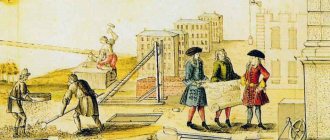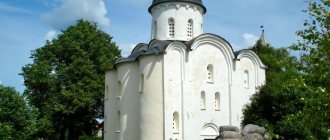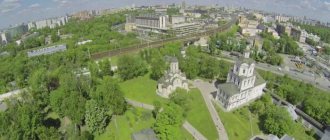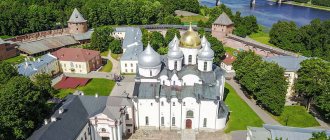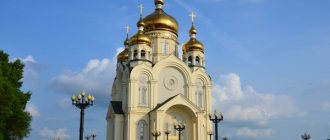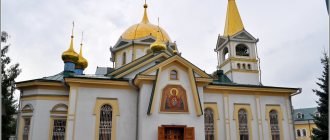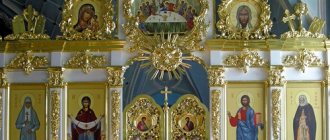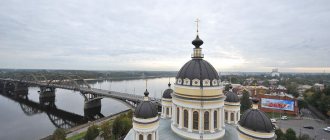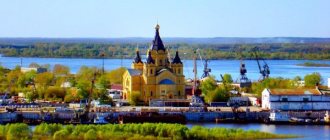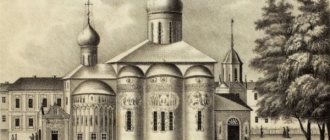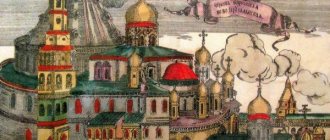| Noginsk Epiphany Cathedral |
Noginsk Cathedral in honor of the Epiphany of the Lord
Bogorodsk deanery of the Moscow diocese
- Altars: Epiphany (main), Intercession of the Most Holy Theotokos, St. Nicholas the Wonderworker
- Address: Russia, 142400, Moscow region, Noginsk (Bogorodsk), st. Rabochaya, 16-a.
- Tel.
- On the map: Yandex.Map, Google map
In the 17th century, on the site of the current cathedral there was a rural church in the name of St. Nicholas of Myra.
In 1755-1767, with donations from parishioners, a stone church was erected in honor of the Epiphany with a chapel in the name of St. Nicholas the Wonderworker. In 1822-1824, a refectory with chapels was added to the church: in honor of the Intercession of the Mother of God (in memory of the deliverance of the city from the French in 1812, which occurred on the Feast of the Intercession) and in the name of St. Nicholas. At the same time, a two-tier bell tower was built.
| Epiphany Cathedral (1911). In the background is the bell tower of the Tikhvin Church file from the site www.bogorodsk-noginsk.ru |
In 1873 the church was named a cathedral.
At the same time, at the request of the parishioners, the cathedral was dismantled, and in 1876 a new, more spacious church was built in honor of the Holy Epiphany of the Lord with the same chapels. In 1885-1886, the bell tower was built with a third tier of bells, and in 1890 a bell weighing 1,250 poods was solemnly placed here - the largest of all the bells in the county towns of Russia, cast with donations from the townspeople. There were 13 bells in total. The cathedral owned: a stone chapel in the church fence (there were more than 90 icons in the chapel); a stone two-story house near the cathedral (built in 1834); a stone chapel on the city square, built by the City Duma in memory of the rescue of the royal family on October 17, 1888; a stone two-story house on Shosseynaya Street with a bench and a wooden outbuilding; wooden one-story building on church land; wooden gatehouse built in 1896.
In 1938, the cathedral was closed, and since 1940, the building housed a boot-felling plant (associated with toxic drugs), and there was a gas distribution station on the territory. In 1953, the Noginsk executive committee attempted to break the domes and dismantle the bell tower, but the cathedral was saved.
In 1989, the temple was handed over to believers. An important event in the life of the temple was the service at the relics of St. Seraphim of Sarov during their transfer to Diveevo in August 1991.
In 1993, the Epiphany Cathedral was captured by schismatics. In November 1997, it was returned to the Russian Orthodox Church. The first service in the returned church was held on November 20, the day of the discovery of the relics of the holy martyr Konstantin Golubev, rector of the cathedral.
Gradually, parish life was restored in the church. Repair work was carried out, new carved iconostases with painted icons were built.
Historical events
In documents dating back to the 14th century, the will of the great Moscow, Vladimir and Novgorod prince Ivan Kalita was preserved to transfer to his wife the village of Rogozh (Rogozha, Rogozhi), which is located in the upper reaches of the Klyazma River. This was the first mention of the settlement, which later became the city.
The origin of the name of the ancient settlement still causes controversy among researchers. According to one version, craftsmen lived here who were engaged in a craft that was very common at that time - making matting. According to another opinion, the name of the village was given by a river that once flowed here. However, there is no reliable data confirming or refuting the above.
The next mention of the village dates back to the 16th century, at which time the settlement was declared Yamskaya. This meant that the villagers were called upon to perform an important government service - delivering government mail to Russian cities all year round.
The only rural wooden church, consecrated in the name of Nicholas the Wonderworker, the patron saint of all travelers, stood on the land that was given to the church by the Prince of Moscow - Vasily III. A century and a half later, parishioners began to collect donations for the construction of a new stone church, which they were going to build on the site of the aged Nikolskaya.
This is how the majestic Epiphany Cathedral appeared in Rogozhskaya Sloboda, one of the boundaries of which was consecrated in memory of St. Nicholas the Pleasant.
In 1781, Catherine II, for the zeal of the Rogozhsky coachmen in performing public service, ordered to give the village a different name - Bogorodsk, awarding it the status of a city and appointing it a county center. Along with the increased scale and importance of the city, the status of the Epiphany Cathedral also increased.
Bishop's services were regularly held here, accompanied by increased attention from the Moscow Synod. As a result, large-scale reconstruction work began here in 1822, which was completed 2 years later. The renewed Epiphany Cathedral acquired a refectory building, a bell tower, a chapel and a security building on its territory.
Epiphany Cathedral, Noginsk
The beginning of the 19th century was a time of new changes in the life of the city; factory textile production began to actively develop here. In addition to small manufactories, large factories of famous philanthropists - Anisim Elagin, Sidor Shibaev, Savva Morozov, Vasily Shalaev - opened their doors in Bogorodsk.
Their large donations allowed work to continue improving the temple complex. Their contributions were used to expand the cathedral, which was decorated with rich paintings and surrounded by a carved forged fence. A two-story building was also built here to house the spiritual administration.
The influx of labor required in Bogorodsk's numerous factories showed that even after the restoration, the city's main cathedral became insufficient to accommodate everyone. And in 1853, Metropolitan Innocent made a difficult decision - to completely dismantle the building and erect a spacious church on the vacant site.
The Epiphany Cathedral (Noginsk) began holding services again in 1876. But it took its final form after reconstruction, which was carried out at the beginning of the 20th century by the architect N.D. Strukov. This is how he appears before us today.
Since 1895, Konstantin Bogorodsky, the future holy martyr in the name of faith, served as the priest of the Epiphany Church. He was canonized by the church, and his relics, acquired in 1995, are kept in the Epiphany Church.
The city, the majority of the population of which were factory and manufacturing workers, accepted the October Revolution immediately and unconditionally. That is why there were no large-scale military operations or significant destruction here. In 1930, proletarian Bogorodsk was renamed Noginsk, after receiving the name of a prominent revolutionary who began his activities at one of the local factories.
Until 1938, services continued in the Epiphany Church; in the period from 1921 to 1925 it was even the Cathedral of the diocese , and in its bishop's choir the future Patriarch of Moscow and All Russia Pimen was a singer.
But all these years, the temple servants were subjected to severe persecution, they were arrested, imprisoned and shot, and the buildings of the temple complex were destroyed and desecrated by vandals. All 13 bells were thrown to the ground from the belfry, and the unique 20-ton bell-blame, installed on the bell tower at one time with the money of parishioners, suffered the same fate. It shattered to pieces.
After the closure of the temple, its buildings were given over to the needs of the city; production workshops were located here; in particular, boot felting production, the technological process of which is accompanied by the release of toxic fumes. The dye shop and gas distribution point had the same destructive effect on the building and the wall painting.
In the 1950s, the city administration attempted to give the building a secular appearance by dismantling the domes and blowing up the bell tower. But that did not happen.
In a deplorable state, the remaining buildings were returned to the Russian Orthodox Church in 1989. After restoration work was carried out, in which eminent Moscow masters participated, regular worship services resumed here.
The year 1991 was remembered by the local clergy and parishioners for a significant event - the temple was awarded the honor of holding a service at the relics of St. Seraphim of Sarov during the solemn ceremony of transferring them to the Diveyevo Monastery.
Another event of recent decades is inscribed in the history of the temple - since 1993, for four years it was in the power of schismatics. Rector Adrian, who served in the Epiphany Cathedral since 1989, left the Russian Orthodox Church and joined the fold of the separated Ukrainian Church. He was defrocked in 1997, and the cathedral was returned to the Russian Orthodox Church.
An Orthodox schism has taken root in Noginsk near Moscow. A representative of the OCU is rampaging here
The modern Noginsk near Moscow, located an hour's drive from the capital, was called Bogorodskoye under the Tsar. The scope of our Russian decommunization was not so strong as to rename the city, but everything else here bears a pre-revolutionary name: the newspaper “Bogorodskie Vesti”, the Bogorodsk diocese, and so on. In short, we read Noginsk, we mean Bogorodsk.
Little difference
Outskirts of Noginsk. Beginning of February. On the left is a residential area of typical 12-story buildings. On the right are various houses of the private sector. Between them is Zharova Street. Above them is a low gray sky, wind and sleet. Private owners are hiding behind high fences, 12-story buildings stand alone in the middle of a bare field, like abandoned children. Bare, dull, unkempt. I turn right into an unnamed alley. This broken snow porridge between the high fences of the outskirts is the road to the temple. The temple itself differs little from the neighboring houses. The same metal fence taller than a man, the same red-yellow brick, the same simple-minded architecture reminiscent of children's drawings: four walls, a gable roof - and the house is ready. The façade of the three-story temple is built with a small square tower. If you look from the side, it seems that a large letter “G” lies behind the fence and looks with its sharp nose into the February sky. This is the Holy Trinity Church, the only temple that makes up the so-called Bogorodsk diocese of the Ukrainian Orthodox Church.
The parish of the Bogorodsk diocese is small - 50-80 people on holidays. These are mostly old women. When from the pulpit the priest proclaims glory not to Patriarch Kirill , but to Ukrainian Patriarch Filaret , few of the parishioners understand that, according to church canons, they are participating in an ungodly schismatic service that does not bring grace. Young people who accidentally wander into a church usually quickly figure out what’s what and hurry to return to the Russian Orthodox Church out of harm’s way. But it’s easy to convince old women that God is one everywhere, and, in essence, what’s the difference. Nevertheless, there is a difference.
Undressed in search of refuge
The name of the rector of the Holy Trinity Church Father Adrian , former Archbishop of Krivoy Rog and Dnepropetrovsk, and now Metropolitan of the OCU, will go down in the history of the Russian Orthodox Church not in the same way as the names of ascetics, but in the same way as the names of apostates. In 1997, the Council of Bishops of the Russian Orthodox Church (ROC) officially deprived Father Adrian of his holy orders, so all the solemn titles that are now attached to this name must be carefully placed in quotation marks - none of them are sanctified by the authority of the church to which he once belonged Father Adrian belonged.
The story of Valentin Yegorovich Starina , in the monasticism of Adrian, is long, extremely confusing, but consistent in its own way. A native of Dnepropetrovsk, Starina began his life's journey as a humble music teacher. However, having crossed the threshold of his 30th birthday, Valentin Yegorovich sharply turned away from the secular path of life. Then there were the Moscow and Leningrad theological seminaries, then the academy, tonsure into monasticism, and in 1989 we find Father Adrian (the name received during tonsure) rector of the Epiphany Cathedral in Noginsk near Moscow in the rank of abbot.
At that time there was no cathedral as such. Services in the temple ceased in 1938. Since then, a boot felting workshop, a dyeing shop and a gas distribution station have coexisted peacefully there. Father Adrian had to turn this boot-felling workshop back into a temple. He did this quite successfully. Within a few years, the cathedral complex included the chapel of the Tikhvin Mother of God, a refectory, a gymnasium, a Sunday school and some small things. For his efforts, Father Adrian was elevated to the rank of archimandrite in 1990.
But there was a fly in the ointment in this ointment. And what a one! This fly in the ointment was shyly called “sexual assault” in legal parlance. The victims were two minor boys who served in the cathedral. One of the boys committed suicide as a result. This shocked fellow priests. By the beginning of the fall of 1992, 24 of the 27 clergy of Noginsk notified the head of the diocese in writing that they did not want to have “further church and personal relations with Father Adrian.” And in October 1992, at a meeting of the diocesan council, the Bogorodsk hierarchs decided: “1. The current critical situation in the Epiphany Cathedral in Noginsk is caused by the unworthy behavior of its rector, Archimandrite Adrian (Starina), expressed in various actions that discredit the high title of pastor of the Church and Christian.
2. The meeting considers it necessary to take immediate measures to heal church disorders in the Epiphany Cathedral in Noginsk.”
The situation was resolved simply but decisively - Father Adrian was removed from the staff, removed from the post of rector, and soon banned from the priesthood. They decided to wait with the application of canonical sanctions. Still, the man returned the cathedral to the city - he must repent. However, Archimandrite Adrian was farther from repentance than ever. The immoral father made it clear that his condemnation is a personal matter for the diocese, and he himself views things differently: he considers the application of ordinary moral requirements to him offensive and meaningless. In short, Father Adrian decided to negotiate with God on his own terms. No sooner said than done. Adrian, no longer abbot, refused to leave the main temple of the city and took up a perimeter defense. In the winter of 1993, Adrian began his many years of sitting in the Epiphany Cathedral in Noginsk.
While the diocese was racking its brains over how to smoke the criminal out of the cathedral, Adrian decided to look for new patrons. But unsuccessfully. The apostate and criminal was consistently rejected, first by the Russian Orthodox Church Outside of Russia (ROCOR) “for grave moral crimes that are impossible within the church’s boundaries,” and then by the so-called “Suzdal schism,” that is, by the Russian Orthodox Free Church (ROC). “The Suzdal residents” expressed themselves very pathetically, but specifically: “For violations of the Apostolic rules and patristic decrees, for admitting persons without holy orders to services and dismissal of the clergy without the knowledge of the bishop, you, Archimandrite Adrian, are prohibited from serving in the priesthood, and your Sacraments, which “Perhaps they will be done by you, without grace, and will serve you not for salvation, but for judgment and condemnation.” Thus, Adrian was officially rejected by three Orthodox institutions - the Moscow Patriarchate, the ROCOR and the Russian Orthodox Church.
It would seem that the defrocked Adrian had nowhere to run, but that was not the case. In the summer of 1992, Kyiv announced the formation of the Kyiv Patriarchate and its separation from the Moscow Patriarchate. It was into this new schism that the exposed criminal went. The new non-canonical patriarchy gladly accepted the Noginsk molester into its fold. In Kyiv they thought the same as Adrian himself - we will come to an agreement with God. Moreover, the main city cathedral and a fairly large parish were attached to the Noginsk disassembly.
“But how can this be?” I turned to an Orthodox priest I knew, who asked not to mention his name, “After all, Adrian was rejected by as many as two churches, he was officially recognized as a criminal, why did the UOC-KP decide to accept him?”
Father was sincerely surprised at my lack of understanding of the situation.
“Priests of the Russian Orthodox Church who have committed a crime, especially on a sexual basis, that is, a terrible crime, very often take the opportunity to become subordinate to the Ukrainian church,” the priest says sadly. “There are two options.” Such a sinful priest can either convince the people of Kiev that he has been slandered, or take advantage of the possibilities of simony, that is, bribery. In general, the Ukrainian church is famous for the fact that a lot is done there for money. There is nothing surprising here. I personally know a person who went through a similar story. When he was accused of homosexuality, and this is a terrible sin, he went to Ukraine, turned to his familiar priests from the Kyiv Patriarchate, and they immediately named the amount with which his problem could be solved. This amount turned out to be unaffordable for him. Then he turned to the Greek Catholics, they quoted the same amount, he went to the autocephalians - the same amount. In the end, he realized that they had all agreed and were holding the market. Then he spat and went to the guards. Perhaps this is the case here too. In Ukraine it is easy to find people who will be ready to accept a person with such sin in their souls. This is not to say that everyone there is like that, but there are such people. In essence, we have resolved the issue. Especially if two factors coincided, that is, if he turned to people like himself, that is, homosexuals, and also paid them. Then he can freely pursue a career in the new jurisdiction.
This means that the sensational story with Father Adrian is only the tip of the iceberg. Of course, no one will say how many sinners like him, contrary to any morality, have gathered under the banners of the OCU. But all world Orthodoxy knows where a criminal can lay his head.
From defrocked to metropolitan
From this moment on, the Noginsky defrocked man begins to make a rapid career. Positions and honorary titles rain down on him as if from a cornucopia. The phantom Kiev Orthodoxy gave birth to freaks, forgiving any sins left and right and with one wave of the hand turning criminals into spiritual teachers. Already in February 1994, Adrian was made Bishop of Dnepropetrovsk and Krivoy Rog. Then he becomes the head of the newly formed Bogorodsk (that is, Noginsk) diocese of the UOC-KP. A little later he rises to the rank of archbishop, and in 2002 he becomes a metropolitan and a permanent member of the Holy Synod of the UOC-KP.
It is necessary to understand that when the President of Ukraine Vladimir Zelensky went to school in Krivoy Rog, the spiritual guardian of his hometown was officially the Noginsky defrocked and molester Archbishop Adrian.
Until the end of the 2000s, the false Adrian lives in two cities - with one foot he runs the non-canonical diocese in Noginsk, with the other - as many as two dioceses in Ukraine.
And again, I turn to canon law experts for clarification: how and why could a defrocked man and a criminal rise to such prominence in the bosom of Ukrainian Orthodoxy?
“If a person who has such crimes in his soul has made such a brilliant career in Kiev, I think this characterizes the receiving party very well,” says the first vice-rector of the Sretensky Theological Seminary of the Moscow Diocese, Father Pavel Velikanov . “As ministers of the Orthodox Church, they know very well, that such crimes generally exclude the presence of a priest in the bosom of the church. He can carry out his repentance all his life, but not in the rank of priest. This story shows very well what Orthodoxy is like from that side. There is no religiosity, but only ideology. Everything that is bad for Moscow is good for Kyiv - if this is how they understand their mission, one can only sympathize with them. This is an indicator of extreme disregard for the foundations of the church structure in favor of the political moment. This is no longer a church, anything but a church. A major theologian and confessor of the 20th century, Sergei Fudel, has such an idea. There is a church and there is a church double, which has the appearance of a church, but by its deeds has renounced the faith. This is a church corpse. I think this story fits well with this concept. The Ukrainian Church is that same church double, it is a corpse.
Two swindlers and one king
While the false Adrian was making a career in Krivoy Rog and Dnepropetrovsk, the newly-minted Kiev Orthodoxy warmed and elevated another swindler, namely Rafail (Prokopyev). This “spiritualized” personality went even further than Father Adrian. Prokopyev created the “Temple of the Archangel Raphael” in the center of Moscow on the street. Radio, considered himself a master of the occult sciences, a spiritual omniscient and a psychic. Considering himself first to one or another schismatic structure in Russia and Ukraine, Raphael changed titles like gloves. Starting with “His Beatitude Metropolitan of Moscow, Guardian of the Doors of the Holy Sepulcher,” he soon consoled himself with a more modest title—“His Holiness Archbishop of Moscow, Metropolitan of All Russia.” He received his consecration from the hands of the hierarchs of the Ukrainian Autocephalous Orthodox Church.
On December 19, 1996, the paths of the “keeper of the doors of the Holy Sepulcher” and the Archbishop of Dnepropetrovsk and Krivoy Rog Adrian crossed in the royal doors of the Epiphany Cathedral in Noginsk near Moscow. On this day, the ceremony of coronation and elevation to the Russian throne of the autocrat of Great, Lesser and White Russia “Emperor Nicholas III ” was officially performed in the temple. The role of the Emperor was played by another, already third, swindler involved in this story - naval sergeant Nikolai Dalsky . To the applause of the disrobed man and the psychic, the newly-minted Nicholas III told the gullible Noginsk believers the story of the miraculous rescue of his father, Tsarevich Alexei, from the Yekaterinburg cellars and painted happy pictures of the future monarchical prosperity of Russia for the audience. For greater persuasiveness, the Emperor of All Rus' during the coronation process in the cathedral was guarded by Ukrainian militants from the UNA-UNSO and Russian freaks from the National Patriotic Front “Memory”.
After such art, the Moscow Patriarchate, still not giving up hope that sooner or later Adrian would repent, announced that the archimandrite, banned from service, had been finally and irrevocably deposed. It is not difficult to guess that this did not stop the Archbishop of Dnepropetrovsk and Krivoy Rog of the UOC-KP. The deeper he fell in the eyes of the Russian Orthodox Church, the higher he climbed the hierarchical ladder of Ukrainian Orthodoxy.
Freedom of religion for crooks
The long-suffering fate of the Epiphany Cathedral in Noginsk deserves special mention. Desecrated first by the Bolsheviks, then by the defrocked, and then completely by the false emperor, the cathedral was in the hands of Adrian until 1997. The question of the jurisdiction of the main temple of the city was resolved long and painfully. Beginning in 1993, Adrian waged an unprecedented property battle with the local administration for the right to own the cathedral. The court met 34 times. At almost every meeting, Adrian presented more and more legal documents for fictitiously created and registered organizations that he allegedly headed. The court, for which everything was clear initially, for almost five years was forced to unravel the casuistic tangles of the former hierarch’s formal claims. By 1997, the court's decision to expel Hadrian from the cathedral finally came into force. But Adrian did not give up here either. He gathered the parish community, consisting mainly of local old women, told them familiar tales about freedom and oppression of the true faith and persuaded them to sign a document on the transfer to Kyiv jurisdiction. As a result, riot police took the cathedral. Between himself and the law, the false priest put up a human shield of parishioners who did not understand anything.
However, even after the Epiphany Cathedral was finally transferred to the jurisdiction of the Russian Orthodox Church, the Bogorodsk diocese of the UOC-KP continued to exist. Adrian moved to the half-abandoned Morozov barracks, organized an altar there and continued to serve. In the end, he was driven from there, then, having made another legal maneuver, he exchanged a place in the barracks for the right to purchase two plots of land on the outskirts of Noginsk and build a house. Instead of a house, the false metropolitan erected the same Holy Trinity Church with which we began this article.
In 2021, the Moscow Regional Court decided to demolish the building at the address. Zharova, 18. The court's arguments are ironclad. Nobody gave Adrian any right to religious activity in this territory. The religious building contradicts existing documents and is subject to demolition. But Adrian found himself in this situation. The entire liberal press of Russia and Ukraine then, in 2021, wrote hysterical reports about the persecution of Ukrainian Orthodoxy and the violation of constitutional freedom of religion. The defrocked child rapist diligently portrayed himself as a victim of a political conflict. The case about the fate of the pseudo-temple has not yet been completed. It is now being considered by the European Court of Human Rights.
Criminal Comedian's Asylum
I open the heavy doors and enter the Holy Trinity Church. There is no service today. The false metropolitan has been in Kyiv for many days now, serving the head of the OCU, Epiphanius. When the position of Adrian's benefactor Philaret on the Kiev political-religious scene was shaken, nothing prevented the hero of our story from turning to the no less non-canonical Epiphanius . The best friend of all dissenters, the false Adrian is now paving the way for the next career leap in Kyiv. After all, new authorities always mean new opportunities...
Inside, the temple is small and looks more like a living room converted into a chapel. The walls are thickly hung with new icons, the colorful iconostasis flickers in the depths of the room with all the colors of the rainbow. To the left of the entrance, among the icons, hangs a large photograph of Epiphanius. There are several children and an elderly man and woman sitting on chairs in front of the door. A woman in a headscarf is a type of classic parishioner. A man in a cassock and glasses with strong prescriptions turns out to be the psalm-reader Svyatoslav . In the thin voice of a castrato, the psalm-reader begins to explain that there is no Bishop Adrian, that he himself is a small man, does not get involved in politics and in general... But gradually the fear passes, a conversation begins. It quickly becomes clear that the psalm-reader’s modesty is feigned. A couple of humble remarks, and he already begins to demonstrate something like shy aggression, like the same hare who scolds the wolf from the bushes.
— Whose jurisdiction is your parish now?
“We are subordinate to the Ecumenical Patriarchate, that is, through the governor in Ukraine, Metropolitan Epiphanius, here is his portrait,” the blind psalm-reader respectfully turns to the photograph of the hierarch, “we are subordinate to the Ecumenical Patriarch Bartholomew .
“But Father Adrian was banned from serving and expelled from his rank.”
- It is banned in the Moscow Patriarchate.
- But isn’t the logic that the severity of moral crimes is the same for different faiths?
“This ban was lifted by Patriarch Bartholomew, he is the Ecumenical Patriarch and it is within his competence to resolve such issues,” says the psalmist, barely hiding a satisfied smile. “The ban was lifted not from Metropolitan Adrian personally, but from everyone.” During the Kharkov Council in 1992, the Moscow Patriarch imposed an anathema on the followers of Philaret during the so-called schism, and now Patriarch Bartholomew has lifted the anathema from our confession. And the Moscow Patriarchate is free to think as it wants.
Svyatoslav slyly gleams his eyes behind thick glasses and is clearly pleased with his position - you think what you want, but we are in chocolate!
“Aren’t you ashamed to serve next to a person who is guilty of a terrible crime?”
Here Svyatoslav’s gaze becomes somehow unfocused and elusive. The face breaks into an unexpected, almost ecstatic smile. I don't know if he understands what I'm asking him.
“Well, everything eventually returns to normal,” Svyatoslav answers inappropriately, “It’s time to scatter stones, time to collect them.” Someday there will be a holiday on our street...
Napoleon's Way
Now Adrian’s defrocked father is approaching eighty, it’s time to think about his soul. But we are dealing with a very specific personality.
“You need to understand what kind of person this is,” says Father Mark , the current rector of the Epiphany Cathedral, “This is a man with a very difficult character.” Extremely ambitious, behaving very defiantly. At all the meetings of our hierarchs, he just spat in people’s faces, was rude, insulted everyone, and behaved in a completely inappropriate manner.
Even the highly tolerant Ukrainian church elite stumbled over the literally Napoleonic ambitions of “Metropolitan Adrian.” In 2009, the Krivoy Rog-Dnepropetrovsk diocese of the UOC-KP was divided in half. Adrian got the Krivoy Rog part. Realizing that the territory under his jurisdiction had been reduced by half, Adrian, skilled in legal matters, immediately formed his own deanery within the borders of the neighboring Dnepropetrovsk diocese. In Kyiv they were horrified by such impudence and quickly removed him from the management of all dioceses of Ukraine. Now “Metropolitan” Adrian has returned to where he came from - he remained the head of the extremely small Bogorodsk diocese on the territory of the Russian Federation. But the legal status of this “diocese” is extremely questionable. Indeed, according to the law, only parishes located on the territory of Ukraine can be considered dioceses of the OCU. By the way, the ECHR, which is supposed to decide the fate of the Holy Trinity pseudo-Church, was extremely critical of all these outrages. Most likely, a decision will be made there to demolish the illegal structure. It is not clear how the inglorious story of the “Metropolitan” will end. But the chick of Patriarch Bartholomew is not used to giving up. If you wait a little, we will probably hear about new scandals involving Adrian.
Architecture, appearance
Epiphany Cathedral (Noginsk) - a monument of the mid-19th century, made in the classical style, is one of the main attractions of the city. According to Byzantine traditions, the structure has a cross-dome structure with an attached four-tier bell tower.
Consisting at first of two tiers, it grew in height during each reconstruction, and today, towering above the city, together with the high drum-lantern and the tented dome of the temple, it creates a dominant position in the vertical space for the complex.
Two chapels are attached to the main structure, where altars with thrones are located, which makes it possible to accompany festive services with several (two or three) liturgies at the same time.
All buildings of the complex are painted sky blue, the beauty of which is emphasized by snow-white decorative elements. The main entrance to the temple is decorated with massive, carved wooden doors, bounded at the top by arched windows.
The elegant, slender bell tower is decorated at the very top with a clock, the dials of which face all four sides. 10 bells of different sizes, from bells to bell ringers, ring out festive chimes throughout the area.
The complex also includes a chapel, a refectory, and also the buildings of a Sunday school and a gymnasium located on the territory. All this is surrounded by a fence made of stone and forged metal.
Interior decoration
The spacious prayer hall from south to north is separated from the altar by a carved iconostasis, which, unlike the classic (5-tiered) one, has four rows of icons. The hall is decorated with a huge chandelier, painted with images of holy saints.
The side iconostases are slightly lower - they have three tiers and are illuminated at night by gilded chandeliers. During the day, sufficient lighting is provided by windows located along the façade of the building and on the drum.
The walls of the temple are partially covered with modern painting (the old painting could not be restored); work on the decoration of the walls and vaults continues today. Only the image of the Tikhvin Mother of God, created by masters before the revolution, remained on one of the walls.
Parishioners constantly go to this shrine with bows. The areas of the walls free from painting are occupied by icons in carved frames. The floor is covered with marble and granite slabs.
In the northern part of the temple, in the annex there is a baptistery. A large round marble pool is built into its floor.
The prayer hall can freely accommodate up to 2.5 thousand parishioners, but so far the number of visitors has not exceeded 1.7 thousand people. For the convenience of those praying in large crowds, the service is broadcast using a sound system throughout the hall and to the street.
Description of the cathedral
Architecture
The cathedral is a cross-domed temple in the style of late classicism (Empire style) with a four-tier bell tower at the base. The central cross of the temple is crowned with a cylindrical drum-lantern covered with a domed head. The front part of the transept is decorated with a pediment, windows, doors and pilasters. The eastern part of the temple ends with a large altar apse. Two chapels are attached to the central part (nave), allowing several liturgies to be performed on holidays. The main entrance to the temple is covered with tall wooden carved doors with an arched window top.
The bell tower is decorated with columns, and under its dome there is a working mechanical clock with dials on four sides. The belfry consists of ten bells: two bells (the main western and northern ones), five bell rings and three bell rings.
At night, the architecture of the temple is emphasized by artistic lighting.
Shrines and interior decoration
The main altar is separated from the temple space by a carved four-tiered iconostasis; a magnificent seven-tiered chandelier with images is suspended under the dome. The solea of the central iconostasis is separated by an openwork gilded fence. The side altars are covered with three-tiered carved iconostases, carpets lie on the soles, and beautiful gilded chandeliers are suspended above the halls. Between the northern aisle and the passage to the main altar there is a shrine containing the relics of Konstantin Bogorodsky. The walls of the passage are decorated with a single slender row of icons, glazed with carved frames and a carved base. The vaults of the temple have not yet been painted, but the Tikhvin image of the Mother of God, revered by parishioners, has been preserved from the pre-revolutionary painting.
Especially revered icons of the temple: the Kazan Icon of the Mother of God, the icon of St. Nicholas, the Novgorod saints with particles of relics and the holy righteous warrior Theodore (Ushakov) with a particle of relics, the image of the Mother of God “Inexhaustible Chalice”. The Vladimir Icon of the Mother of God, which belonged to Father Konstantin, is kept in the altar.
In the northern part of the temple, behind the altar, there is a baptistery with a large marble pool. In the southern part there is a small utility room.
The temple has four fenced wooden choirs, two central ones with inclined pulpits. There are benches for the infirm along the western walls and choirs. Candle boxes are installed along the walls of the vestibule, notices are hung, here are the entrances to the utility rooms and the exit to the bell tower staircase. The flooring in the temple is decorated with durable marble slabs, and along the central lines from the Royal Doors - with granite slabs. The window sills are also made from granite slabs. During daylight hours, the temple is well lit with natural light; during dark times, electric lighting is used. The heating is centralized, the temple is equipped with forced ventilation. On major holidays, when there is a large crowd of people, a sound system is used, transmitting prayer and choral singing to remote corners of the temple and to the street.
The temple can accommodate up to 2.5 thousand visitors, and on major holidays there are up to 1,700 people in the temple. The cathedral is currently being painted.
Temple grounds
The cathedral complex includes the Temple itself, a chapel-temple with a church bench and a richly decorated large Tikhvin image inside, a two-story gatehouse building, a two-story refectory building, a two-story gymnasium building with attics, a two-story Sunday school building, and a stone and metal fence. There is a common toilet and washbasin on the territory of the cathedral.
Shrines
The Epiphany Cathedral (Noginsk) has shrines, which not only local residents come to worship, but also residents of other cities make pilgrimages.
In addition to the image of the Tikhvin Mother of God preserved from the century before last, the following are especially revered:
- images of the Mother of God of Kazan and the “Inexhaustible Chalice”;
- icon of St. Nicholas the Wonderworker;
- relics of St. Konstantin Bogorodsky.
Social activities of the cathedral
The Epiphany Cathedral is known in Noginsk and beyond for its extensive and versatile activities, aimed at the spiritual education of parishioners of different ages. A Sunday school (adult and children's sections) is open here for everyone, where the Law of God is taught in an accessible form, conversations about spirituality are held, and there is a kindergarten.
Folk art and handicraft circles operate at the temple, pilgrimage groups are created, and choral associations operate. The cathedral library is open to everyone 4 times a week for 2 hours (from 12-00 to 14-00). It is possible to take advantage of the rich video library.
The charitable society "Mercy" has been providing active assistance in orphanages, hospitals, and nursing homes for several years. His attention also extends to prisoners in prisons.
The workshop where the icon painters work provides images of saints not only to the church shop, but also carries out orders for the decoration of other churches. There is a circle here where capable children learn the art of icon painting.
Every month the newspaper “Resurrection and Life” is published, which contains educational articles, covers news, and publishes instructions and sermons. Much attention is paid to the promotion of creative teams. In addition, the community takes an active part in daily radio and video broadcasts from the city studio “Bogorodsk”.
How to get there by car, public transport
Noginsk is located in the Moscow region, 55 km from the capital. The Epiphany Cathedral, located in the city center, can be reached from Moscow, both by road and by rail.
By train
Electric trains depart daily from Kursky Station in the direction of Noginsk at intervals of 1-1.5 hours. Travel time is 1.5 hours, fare is from 195 rubles.
From the Noginsk station you should walk along Komsomolskaya Street to Patriarchaya Street, then head towards Rabochaya Street. The landmark is the monument to Patriarch Pimen. Distance – 700 m, travel time – 10-15 minutes.
By bus
Buses NN 322e and 382, departing from the Partizanskaya metro station to Noginsk every 10-20 minutes, arrive at the city bus station after 1 hour 10 minutes.
From the city bus station, located on Komsomolskaya Street, 26 (not far from the railway station), you should repeat the route described above.
By car, taxi
From the center of Moscow you will have to travel about 60 km by car. Without traffic jams, this journey will take about 1 hour. Along the Entuziastov Highway, which turns into the federal highway M7 "Volga" (Gorkovskoe Highway), you need to get to Noginsk, turning onto 3rd International Street, and after the Noginsky Park of Culture and Leisure - onto Rabochaya Street.
A taxi ride will cost from 1300 rubles.
Pilgrimage and excursion trips
Pilgrimage trips to the Noginsk Epiphany Cathedral are organized by Orthodox communities of parishes in different cities of Russia. Usually they are timed to coincide with the Day of Remembrance of St. Constantine of Bogorodsky (October 2, new style).
A visit to the cathedral is also included in the programs of tourist trips to Noginsk. Local guides offer a sightseeing tour of the city for 3,000 rubles. from a group of up to 10 people. One-day trips from Moscow with the operator “Travel Store” (Kuznetsky Most St., 21/5), which last 9-11 hours, cost from 2100 rubles. per person.
Schedule of services of the Epiphany Cathedral in Noginsk 2017
The chapel is open every day at 07:00 in the morning until 18:30 in the evening, on Sundays and on holidays from 05:00 in the morning, and before them until 19:00.
For the period from 20.10 to 05.11, the following schedule of services has been established in the temple.
October 20th Martyrs of Bacchus and Sergius:
- pilgrimage, at the end the prayer service is read and the memorial service is performed at 8 am;
- Evening ceremonies began at 5 pm.
The best article for you, go to: Sretensky Monastery in Moscow
October 21st. Venerable Pelagia:
- 8:00 – pilgrimage, upon completion, saying a prayer service, holding a memorial service;
- The all-night Sunday vigil is held at 5 p.m.
October 22, 20th week after the Exaltation, after Pentecost:
- the early hours pilgrimage will take place at 6 a.m.;
- 9:00 – late pilgrimage;
- 17:00 – prayer chant with reading of an akathist to Konstantin Bogorodsky. Water blessing.
October 23rd of the Holy Venerable Elder Ambrose of Optina:
- 7:40 – pilgrimage, at the end reading a prayer service, holding a memorial service;
- 17:00 – sacred service in the evening hours.
October 24th of one from seven deacons, Apostle Philip:
- 8:00 – chanting, at the end reading a prayer service, holding a memorial service;
- evening ritual (5 pm).
October 25th of the creator of the canons of the Bishop of Maium, Saint Cosmas:
- 8:00 – chanting, at the end saying a prayer service, holding a memorial service;
- 17:00 – evening service.
October 26th of the miraculous image of the Iveron Mother of God:
- 8:00 – chanting, at the end saying a prayer service, holding a memorial service;
- The evening service will take place at 5 p.m.
October 27th of St. Paraskeva-Petka of Serbia:
- 8:00 – chanting, after the reading of the prayer service, holding a memorial service;
- 17:00 – evening service.
October 28th Parents' Saturday (Dimitrievskaya):
- 6:00 – service in the early hours;
- 9:00 – pilgrimage in the late hours;
- All-night evening vigil – beginning at 5 pm.
The best article for you, go to: Resurrection Cathedral in Omsk
October 29, 21st week after the Exaltation, after Pentecost:
- 6:00 – early rite;
- 9:00 – service in late hours;
- 17:00 – water blessing. A prayer chant with the recitation of an akathist to Konstantin Bogorodsky.
October 30th of the Venerable Martyr Andrew of Crete:
- 7:40 – chanting, at the end saying a prayer service, holding a memorial service;
- 17:00 – evening ritual.
October 31st, Evangelist and Preacher Luke:
- 8:00 – chanting, at the end saying a prayer service, holding a memorial service;
- The evening service takes place at 5 pm.
November 1st of the martyr Huar and the seven martyrs with him:
- 8:00 – pilgrimage, at the end reading a prayer service, holding a memorial service;
- 17:00 – evening service.
November 2nd of the Great Martyr Artemy, the Righteous Youth of Verkolsky Artemy:
- 8:00 – pilgrimage, at the end saying a prayer service, holding a memorial service;
- Evening pilgrimage starts at 5 pm.
November 3rd of the Great Saint Hilarion:
- 8:00 – chanting, at the end reading a prayer service, holding a memorial service;
- 17:00 – pilgrimage in the evening.
November 4th celebration in honor of the divine face of the Kazan Heavenly Queen:
- 8:00 – Divine chant;
- The all-night Sunday vigil begins at 5 pm.
The best article for you, go to: Spaso-Preobrazhensky Monastery Murom
November 5, 22nd week after the Exaltation, after Pentecost:
- 6:00 – holding services in the early hours;
- 9:00 – holding services in late hours;
- 17:00 – prayer chant with reading of the akathist to Konstantin Bogorodsky. Water blessing.
Where to stay
In modern Noginsk, for guests who independently visited the city for pilgrimage, tourism or other purposes, there are many hotels with rooms of different categories. Some of them are located in the historical center, within walking distance of the Epiphany Cathedral.
Hotel "Gostiny Dvor"
A small hotel, opened two years ago, is located on the banks of the Klyazma, at the address: st. Rabochaya, 48. Its 11 rooms, belonging to the Economy and Standard categories, are equipped with modern, comfortable furniture, household appliances, and a private bathroom. Each room has digital TV, split-system, tea sets.
In the “Standard” category, additional upholstered furniture, coffee and desk tables, and electronic safes are installed. In the bathrooms there are sets of towels and personal hygiene products.
For travelers by car, parking and free Wi-Fi are available throughout the hotel. Those who wish can take advantage of the sauna.
The hotel has a kitchen where you can prepare different dishes yourself. There is everything you need for this: household appliances, sets of pots and pans, tableware.
In addition to the Epiphany Cathedral, in the immediate vicinity of Gostiny Dvor there is a railway station, a bus station, a local history museum, a drama theater, as well as shops and catering establishments. Cost of living – 2500-3900 rubles.
Hotel complex "Green Noise"
The hotel is located on Kartonny dead end street, in house 1, within the city, 3.7 km from the Epiphany Cathedral. Surrounded by picturesque nature, standing on the banks of the river, it creates a feeling of a country holiday. Guests have a choice of comfortable rooms for 1-4 people with the necessary furniture and bathrooms.
Each room has television, wireless Internet, air conditioning, electric kettles.
The complex has restaurants and bars, and you can order food delivered to your room, as well as grocery delivery from nearby shops. For an additional fee, hotel guests can use laundry, dry cleaning, SPA center and rental services.
In addition to issuing regular sports equipment, it provides full equipment for those wishing to engage in water sports or fishing. Room rates (without meals) – from 4,000 to 7,000 rubles.
Hostel "Rus-Noginsk"
At the address: st. Elektricheskaya, building 1, 2 km from the Epiphany Cathedral, there is a hostel where you can choose a bed in a 4- or 6-bed room or a separate room for two. The advantage of its location is the well-developed infrastructure of a densely populated area, the proximity of a bus and railway station, as well as the main city attractions.
All interiors are decorated in light colors. The common rooms are furnished with 2-bunk beds with curtains. The bathroom and shower room are located in the corridor. The cost of a bed is 450 rubles.
Separate rooms have single and double beds, refrigerator, kitchenette, TV. Residents use a toilet and bathroom on the floor. The rooms have a separate entrance. Cost of living – 1300 rubles.
The shared kitchen is equipped with everything necessary for cooking, there is a stove, refrigerator, and microwave. Groceries can be purchased at the nearby supermarket. The nearest restaurant "Berkut" is several bus stops away.
Temple of the Martyr and Patriarch in Noginsk
On the banks of the Klyazma River in the historical center of Noginsk stands the main temple of the city - the Epiphany Cathedral. Here are the relics of the holy martyr Konstantin Golubev, killed for his faith in 1918. For many years, the site of the execution and burial of the priest in the grove behind the Avtomobilist city stadium was revered by believers. In 1995, his remains were found, and since 2004 they have been exhibited in a shrine in the Epiphany Cathedral. In the 1920s, the future patriarch Pimen Izvekov sang in the choir at the Epiphany Cathedral. A memorial plaque at the entrance to the temple and a bronze monument to the patriarch, erected not far from the cathedral, remind us of this.
Hieromartyr Konstantin Golubev was born in the village of Baranovka, Volsky district, Saratov province. This area was known as a schismatic region, where dozens of villages belonged to different Old Believers. In Baranovka, as stated in the life of the holy martyr, there were four concords: the Spasovtsy, the Pomeranians, the Beglopopovtsy and the priestly poptsy of the Belokrinitsky hierarchy. The Spasovites predominated among other movements, but they, in turn, were divided into four more movements. Konstantin Golubev was the son of a psalm-reader at the Orthodox Church in the village of Baranovka. Having entered the Saratov Theological Seminary, he felt a calling to missionary service among schismatics and sectarians. K. Golubev did not take the priesthood, but joined the missionary Brotherhood of the Holy Cross formed in the Saratov diocese. Returning to his native Baranovka, the young missionary took up religious education of his fellow villagers. For almost twenty years, Konstantin Golubev worked as a missionary in the Saratov diocese, uniting Old Believers, Molokans and sectarians with the Synodal Church.
In 1895, a turn took place in the missionary's life. At the age of forty-three, he accepted holy orders and was sent to serve in the Moscow province. Bogorodsky district was at that time the center of the split in the vicinity of the old capital, although here, unlike the Volsky district of the Saratov province, it was not Bespopovites who prevailed, but adherents of the Belokrinitsky consent. Bogorodsk manufacturer Arseny Ivanovich Morozov, owner of the Glukhovskaya manufactory, also belonged to this sense. Priest Konstantin Golubev became rector of the Epiphany Cathedral in Bogorodsk, continuing his anti-schism activities in a new capacity and in a new place. In addition to the Old Believers, the priest found here “brothers”, Baptists, Pashkovites and Adventists.
Mass repressions against the clergy, executions and closure of churches did not occur immediately after the 1917 revolution. Most of the celebrated holy martyrs of the 20th century died in the late 1930s. However, Konstantin Golubev became one of the first victims for his faith. In the fall of 1918, the priest was arrested by the new government and soon shot on the outskirts of the city in the forest. In “The Lives of the New Martyrs and Russian Confessors of the 20th Century of the Moscow Diocese” by Hegumen Damaskin Orlovsky it is said that the ravine in the grove, which became the grave of the priest, was revered for a long time by the residents of Bogorodsk-Noginsk: “Requiem services were often served at the grave, a lamp was burning, icons and flowers were brought here. The atheists, discovering these signs of veneration, destroyed the grave mound.” In November 1995, the grave of the Holy Martyr Constantine was rediscovered, and the relics were transferred first to the Tikhvin Church in Noginsk, and in 2004 to the Epiphany Cathedral, where the shepherd served before the revolution.
In 1918, when the massacre of the Hieromartyr Constantine took place, the future Patriarch Pimen, Sergei Mikhailovich Izvekov, turned eight years old. The boy lived with his parents in Bogorodsk, his father worked as a mechanic at the Glukhov factory. Mikhail Karpovich Izvekov made an unusual chandelier for the Tikhvin Church of Bogorodsk in the form of a huge cross. Valentin Nikitin, in a book about Patriarch Pimen, wrote: “Composed of multi-colored glass, the cross emitted a soft matte light. Multi-colored lamps glowed on its edges.” The patriarch's mother, Pelageya Afanasyevna, was buried in the graveyard of the same Tikhvin church. In the 1920s, the future hierarch sang in the choir of the Epiphany Cathedral in Bogorodsk.
The parish website of the Epiphany Cathedral states that the altar contains a copy of the icon of the Vladimir Mother of God, which belonged to Hieromartyr Konstantin Golubev. This image played a special role in the life of Patriarch Pimen Izvekov. Pimen recalled: “The Vladimir image of the Mother of God is a Moscow shrine, a shrine of the places where I was born. He was our family image, he became my image on the path of monastic work. On the day of the celebration of the same image, with the blessing of the Queen of Heaven, my enthronement took place.” In 1925, as a fifteen-year-old youth, Sergei Izvekov came to the Sarov Hermitage, wanting to become a monk, but the elders instructed him to go to Moscow. He arrived in the capital on the day of the feast of the Presentation of the Vladimir Icon and was accepted into the brethren of the Sretensky Monastery. Many years later, on the third of June 1971, on the day of the Vladimir Icon of the Mother of God, Pimen Izvekov was elected Patriarch of Moscow and All Rus'. In the Epiphany Cathedral in Moscow, the elected patriarch was presented with another copy of the Vladimir Icon after his enthronement.
For almost twenty years, Pimen led the Russian Church under conditions of constant control and pressure from the authorities. The last years of Pimen's life and patriarchate were marked by a historical event - the celebration of the 1000th anniversary of the Baptism of Rus' in 1988. This was a turning point in the relationship between the state and the church, the beginning of religious freedom.
Interesting facts and legends
One of the main shrines of the Epiphany Cathedral is the relics of Constantine Bogorodsky, canonized in 1996 by the Russian Orthodox Church. The rector Konstantin Golubev was arrested and shot for organizing a religious procession in 1918. During the execution, the clergyman was seriously wounded and thrown into the grave while still alive.
The dying man's requests and his daughter's pleas for an end to the torment were not heard by the executioners. He was buried alive. The burial site at the edge of the forest has always been a place of pilgrimage; people, despite the ban, brought candles here and read prayers.
There is a legend that two soldiers who refused to shoot at the priest were executed along with Father Konstantin. The discovery of his relics took place in 1995, and since 2004 they have been kept in the Epiphany Cathedral.
In 2010, in the city, not far from the Epiphany Cathedral, a monument was erected to Patriarch Pimen, who headed the Russian Orthodox Church during the Soviet years for 20 years, and in the 1920s sang in the church choir of the temple. Some sources claim that Bogorodsk (Noginsk) is the birthplace of Pimen, but this opinion is erroneous. The author of the monument is the sculptor I. Komochkin.
The height of the sculpture on the pedestal reaches 7 m; steps lead to the platform on which it is installed. The Patriarch is depicted in full height, in ceremonial attire, with a raised blessing hand.
The Epiphany Cathedral has always been and remains the main shrine and landmark of the city. Built with the money of believers in the middle of the 19th century, it went through a difficult path with its parish, and, having been reborn, remained the spiritual center of today's Noginsk.
Epiphany Cathedral
Bogorodsky urban district, Noginsk, st. Rabochaya, 16a, 1755 Patronal feast: Epiphany of the Lord (January 19) Side chapels
- Protection of the Mother of God (October 14)
- St. Nicholas of Myra (May 22, August 11, December 19)
Ascribed temples
- home temple of Equal. led book Vladimir
- temple of the blessed Ksenia of Petersburg
- MC temple Tatiana
- temple of st. Luke of Simferopol
- temple of st. Nicholas of Myra
- Chapel of the Icon of the Mother of God "Tikhvin"
- Chapel of St. Nicholas of Myra
- Chapel of St. Nicholas of Myra
Address: Bogorodsky urban district, Noginsk, st.
Rabochaya, 16a Telephone, 8 (495) 511-23-32 Official website: bogorodsk-blago.ru In the 17th century. the city of Noginsk was the Yamsky village of Rogozha. In it, on the site of the current cathedral, there was a temple in the name of St. Nicholas. In 1755-1767 In the village of Rogozha (Old Rogozhsky Yam), a stone church in honor of the Epiphany with a chapel in the name of St. Nicholas the Wonderworker was erected with donations from parishioners. In 1782, the village received city status and was renamed Bogorodsk. In 1822-1824. a refectory with side chapels was added to the church: in honor of the Intercession of the Mother of God (in memory of the deliverance of the city from the French in 1812, which occurred on the Feast of the Intercession) and in the name of St. Nicholas. At the same time, a two-tier bell tower was built. In 1873 the church was named a cathedral. At the same time, at the request of the parishioners, the cathedral was dismantled, and in 1876 a new, more spacious church was built in honor of the Holy Epiphany of the Lord with the same chapels. In 1885-1886 the bell tower was built with a third tier of bells, and in 1890 a bell weighing 1,250 poods was solemnly placed here - the largest of all the bells in the county towns of Russia, cast with donations from the townspeople. There were 13 bells in total.
The cathedral owned: a stone chapel in the church fence (there were more than 90 icons in the chapel); a stone two-story house near the cathedral (built in 1834); a stone chapel on the city square, built by the City Duma in memory of the rescue of the royal family on October 17, 1888; a stone two-story house on Shosseynaya Street with a bench and a wooden outbuilding; wooden one-story building on church land; wooden gatehouse built in 1896
Since 1895, the future martyr Konstantin Bogorodsky (Archpriest Konstantin Alekseevich Golubev, 1852-1918; commemorated October 2, Old Art.) was appointed rector. His venerable relics were found on November 20, 1995 and currently rest in the Tikhvin Church of Noginsk (Bogorodsk).
Then Archpriest Nikolai Alexandrovich Speransky became the rector of the Epiphany Cathedral. In 1931 he was arrested and deported, returning from exile in the mid-1930s. In 1937, he was arrested again and executed in Butovo. A similar fate awaited the majority of clergy and active parishioners of the Epiphany Cathedral. The rector of the cathedral during this difficult period for the Church was Hieromartyr Sergius (Archpriest Sergius Konstantinovich Mahaev; 1874-1937, shot in Butovo on December 2), and after his arrest - Hieromartyr Nicholas (Priest Nikolai Alexandrovich Andreev; 1869-1937, shot on December 10 in Butovo ).
The cathedral was closed in 1938; since 1940, the building housed a boot-felling plant (associated with toxic drugs), and there was a gas distribution station on the territory. In 1953, the Noginsk executive committee attempted to break the domes and dismantle the bell tower, but the cathedral was saved.
In 1989, the temple was handed over to believers. An important event in the life of the temple was the service at the relics of St. Seraphim of Sarov during their transfer to Diveevo in August 1991. In 1993, the Epiphany Cathedral was captured by schismatics. In November 1997, it was returned to the Russian Orthodox Church. It is significant that the first divine service in the returned temple was performed on the day of the discovery of the relics of the holy martyr Constantine - November 20. Gradually, parish life was restored in the church. Repair work was carried out, new carved iconostases with painted icons were built.
Chapels are assigned to the cathedral: in honor of the Tikhvin Icon of the Mother of God on the territory of the cathedral; in memory of those who fell in the Great Patriotic War on Victory Square; chapel in the city cemetery.
Among the cathedral's shrines: the Tikhvin image of the Mother of God, preserved from pre-revolutionary painting; Kazan Icon of the Mother of God; icons of St. Nicholas, Novgorod saints with particles of relics; the holy righteous warrior Theodore (Ushakov) with a particle of relics, the Vladimir Icon of the Mother of God, which belonged to the Hieromartyr Konstantin Bogorodsky (in the altar).
More news and photos from the temple:
- Celebration of the memory of the Council of the New Martyrs of Bogorodsk on November 20, 2020
- Memorial Day of Hieromartyr Konstantin Bogorodsky in Noginsk October 2, 2021
- Commemoration of the Council of the New Martyrs of Bogorodsk and the meeting of the Department for Cooperation with the Armed Forces and Law Enforcement Agencies in Noginsk on November 20, 2021
- The start of advanced training courses for clergy in Noginsk on September 2, 2021
- Presentation of gifts to schoolchildren from large families in Noginsk on August 28, 2021
- Meeting of teachers teaching spiritual and moral subjects in Noginsk on August 27, 2021
- Day of Knowledge at the Orthodox Gymnasium named after the Hieromartyr Konstantin Bogorodsky on September 2, 2021
